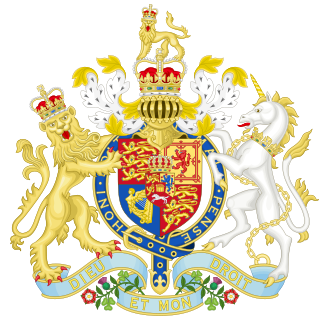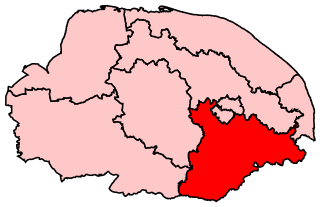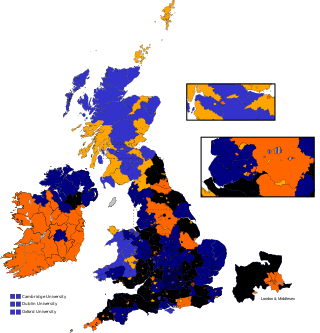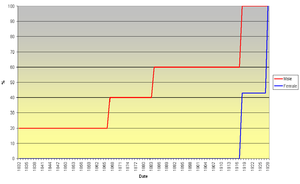
The Representation of the People Act 1832 was an Act of Parliament of the United Kingdom that introduced major changes to the electoral system of England and Wales. It abolished tiny districts, gave representation to cities, gave the vote to small landowners, tenant farmers, shopkeepers, householders who paid a yearly rental of £10 or more, and some lodgers. Only qualifying men were able to vote; the Act introduced the first explicit statutory bar to women voting by defining a voter as a male person.

In the United Kingdom under the premiership of William Gladstone, the Representation of the People Act 1884 and the Redistribution Act of the following year were laws which further extended the suffrage in the UK after the Derby Government's Reform Act 1867. Taken together, these measures extended the same voting qualifications as existed in the towns to the countryside, more than doubling the electorate in the counties, and essentially established the modern one member constituency as the normal pattern for Parliamentary representation.
The Radicals were a loose parliamentary political grouping in Great Britain and Ireland in the early to mid-19th century who drew on earlier ideas of radicalism and helped to transform the Whigs into the Liberal Party.

The Representation of the People Act 1867, 30 & 31 Vict. c. 102 was a piece of British legislation that enfranchised part of the urban male working class in England and Wales for the first time. It took effect in stages over the next two years, culminating in full commencement on 1 January 1869.

The Representation of the People Act 1918 was an Act of Parliament passed to reform the electoral system in Great Britain and Ireland. It is sometimes known as the Fourth Reform Act. The Act extended the franchise in parliamentary elections, also known as the right to vote, to men aged over 21, whether or not they owned property, and to women aged over 30 who resided in the constituency or occupied land or premises with a rateable value above £5, or whose husbands did. At the same time, it extended the local government franchise to include women aged over 21 on the same terms as men. It came into effect at the 1918 general election.

South Norfolk is a constituency represented in the House of Commons of the UK Parliament since 2001 by Richard Bacon, a Conservative.
Knight of the shire was the formal title for a member of parliament (MP) representing a county constituency in the British House of Commons, from its origins in the medieval Parliament of England until the Redistribution of Seats Act 1885 ended the practice of each county forming a single constituency. The corresponding titles for other MPs were burgess in a borough constituency and baron for a Cinque Ports constituency. Knights of the shire had more prestige than burgesses, and sitting burgesses often stood for election for the shire in the hope of increasing their standing in Parliament.
Representation of the People Act is a stock short title used in Antigua and Barbuda, The Bahamas, Bangladesh, Barbados, Belize, Ghana, Grenada, Guyana, India, Jamaica, Mauritius, Pakistan, Saint Vincent and the Grenadines, Trinidad and Tobago, the United Kingdom and Vanuatu for legislation dealing with the electoral system. Representation of the People Acts is a collective title for legislation relating to representation of the people, including Rating Acts and other Registration Acts. The title was first used in the United Kingdom in the 1832 Great Reform Act and was adopted in other countries of, or formerly part of, the British Empire thorugh the spread of the Westminster parliamentary system.

The Redistribution of Seats Act 1885 was an Act of the Parliament of the United Kingdom. It was a piece of electoral reform legislation that redistributed the seats in the House of Commons, introducing the concept of equally populated constituencies, a concept in the broader global context termed equal apportionment, in an attempt to equalise representation across the UK. It was associated with, but not part of, the Representation of the People Act 1884.
London University was a university constituency electing one Member of Parliament (MP) to the House of Commons of the Parliament of the United Kingdom, from 1868 to 1950.
Arundel was twice a parliamentary constituency in the Kingdom of England, the Kingdom of Great Britain, and the United Kingdom. The first incarnation strictly comprised the town centre of Arundel and was a borough constituency in Sussex first enfranchised in 1332 and disfranchised in 1868 under the Reform Act 1867. Arundel initially elected two members, but this was reduced to one in 1832 by the Great Reform Act.

South Essex was a county constituency represented in the House of Commons of the Parliament of the United Kingdom from 1832 to 1885. It elected two Members of Parliament (MPs) using the bloc vote system.
East Cheshire was parliamentary constituency which returned two Members of Parliament (MPs) to the House of Commons of the Parliament of the United Kingdom. Elections were held using the bloc vote system.
Mid Cheshire is a former United Kingdom parliamentary constituency.
West Cheshire is a former parliamentary constituency, which returned two Members of Parliament (MPs) to the House of Commons of the Parliament of the United Kingdom.
Woodstock, sometimes called New Woodstock, was a parliamentary constituency in the United Kingdom named after the town of Woodstock in the county of Oxfordshire.
Brighton was a parliamentary constituency of the House of Commons of the Parliament of the United Kingdom from 1832 until it was divided into single-member seats from the 1950 United Kingdom general election. Covering the seaside towns of Brighton and Hove in East Sussex, it elected two Members of Parliament (MP) by the block vote system of election.

A movement to fight for women's right to vote in the United Kingdom finally succeeded through acts of Parliament in 1918 and 1928. It became a national movement in the Victorian era. Women were not explicitly banned from voting in Great Britain until the Reform Act 1832 and the Municipal Corporations Act 1835. In 1872 the fight for women's suffrage became a national movement with the formation of the National Society for Women's Suffrage and later the more influential National Union of Women's Suffrage Societies (NUWSS). As well as in England, women's suffrage movements in Wales, Scotland and other parts of the United Kingdom gained momentum. The movements shifted sentiments in favour of woman suffrage by 1906. It was at this point that the militant campaign began with the formation of the Women's Social and Political Union (WSPU).

South Lincolnshire, formally called the Southern Division of Lincolnshire or Parts of Kesteven and Holland, was a county constituency in Lincolnshire. It returned two Members of Parliament (MPs) to the House of Commons of the Parliament of the United Kingdom, elected by the bloc vote electoral system.

The 1885 general election in Ireland was the first election following the Representation of the People Act 1884 and the Redistribution of Seats Act 1885, which redrew the Irish electoral landscape.







